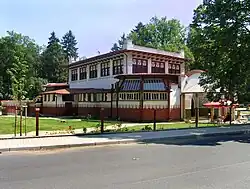Mšené-lázně
Mšené-lázně is a spa municipality and village in Litoměřice District in the Ústí nad Labem Region of the Czech Republic. It has about 1,800 inhabitants.
Mšené-lázně | |
|---|---|
 Main building of Mšené spa | |
 Flag  Coat of arms | |
 Mšené-lázně Location in the Czech Republic | |
| Coordinates: 50°21′44″N 14°7′38″E | |
| Country | |
| Region | Ústí nad Labem |
| District | Litoměřice |
| First mentioned | 1262 |
| Area | |
| • Total | 37.27 km2 (14.39 sq mi) |
| Elevation | 213 m (699 ft) |
| Population (2023-01-01)[1] | |
| • Total | 1,840 |
| • Density | 49/km2 (130/sq mi) |
| Time zone | UTC+1 (CET) |
| • Summer (DST) | UTC+2 (CEST) |
| Postal codes | 411 19, 411 20 |
| Website | www |
Administrative parts
Villages of Brníkov, Ječovice, Podbradec, Ředhošť and Vrbice are administrative parts of Mšené-lázně.
Geography
Mšené-lázně is located about 19 kilometres (12 mi) south of Litoměřice and 35 km (22 mi) northwest of Prague. It lies in a flat and mainly agricultural landscape of the Lower Eger Table. The highest point is at 294 m (965 ft) above sea level. The Mšenský Stream flows through the municipality.
Spa
Mšené Spa was founded in 1796. The local water is rich in iron and other minerals. The spa treat especially disorders of muscular system and nerves.[3]
Sights
Among the landmarks of the municipality belong Mšené Castle, Chapel of the Saint John of Nepomuk and the town hall.[2]
A fortress, probably built around 1400, was rebuilt into the early Baroque castle in 1660. It was modified in 1748 and then rebuilt in the Neo-Renaissance style at the end of the 19th century. Today it is privately owned and inaccessible.[4]
Notable people
- František Bayer (1854–1936), zoologist and paleontologist
- Antonín Hudeček (1872–1941), landscape painter
Gallery
 A house in Lázeňská street
A house in Lázeňská street Spa park
Spa park
References
- "Population of Municipalities – 1 January 2023". Czech Statistical Office. 2023-05-23.
- "Mšené-lázně (in English)". Obec Mšené-lázně. Retrieved 2022-09-14.
- "Historie lázní" (in Czech). Lázně Mšené. Retrieved 2020-08-19.
- "Zámek" (in Czech). National Heritage Institute. Retrieved 2023-07-04.
